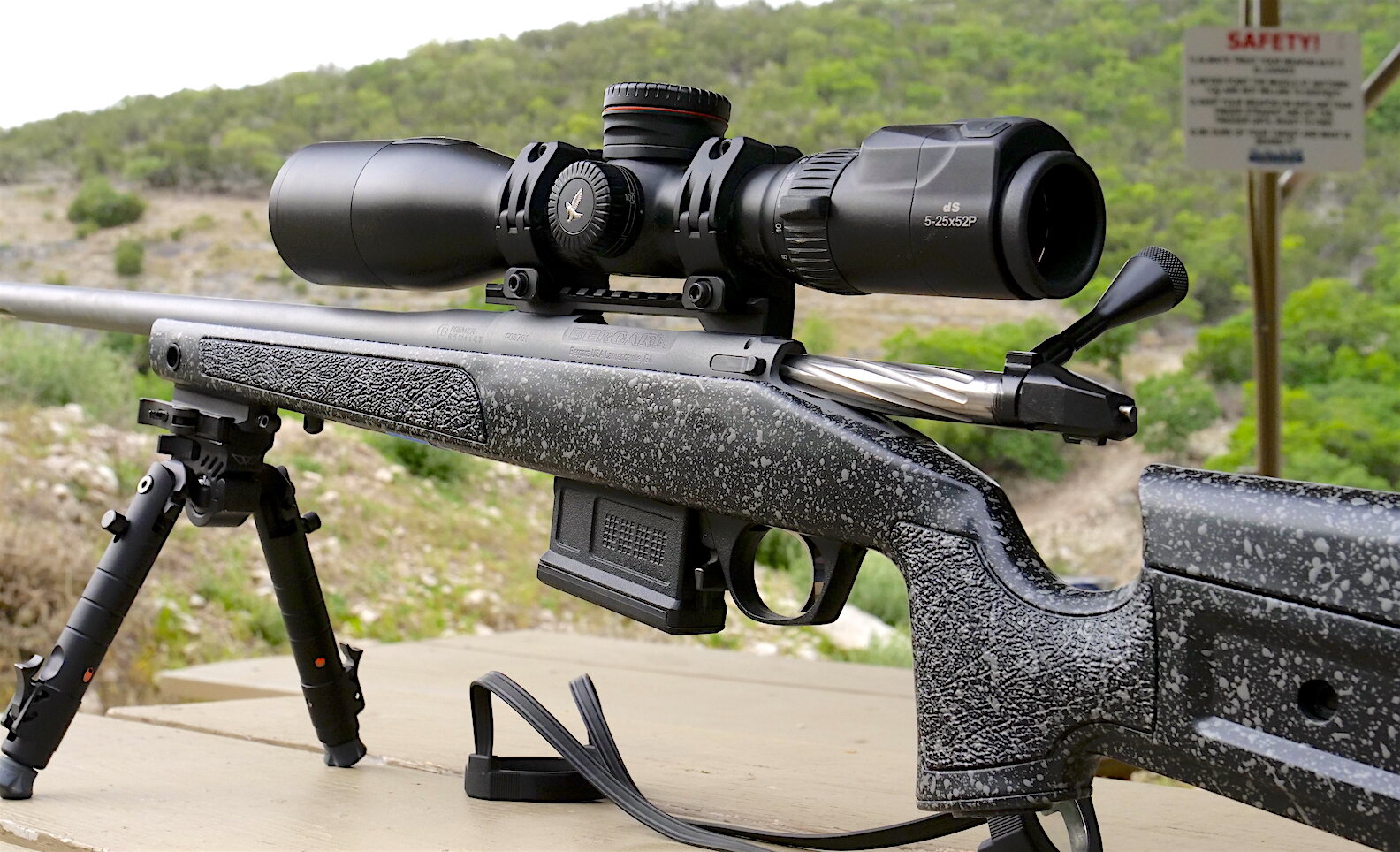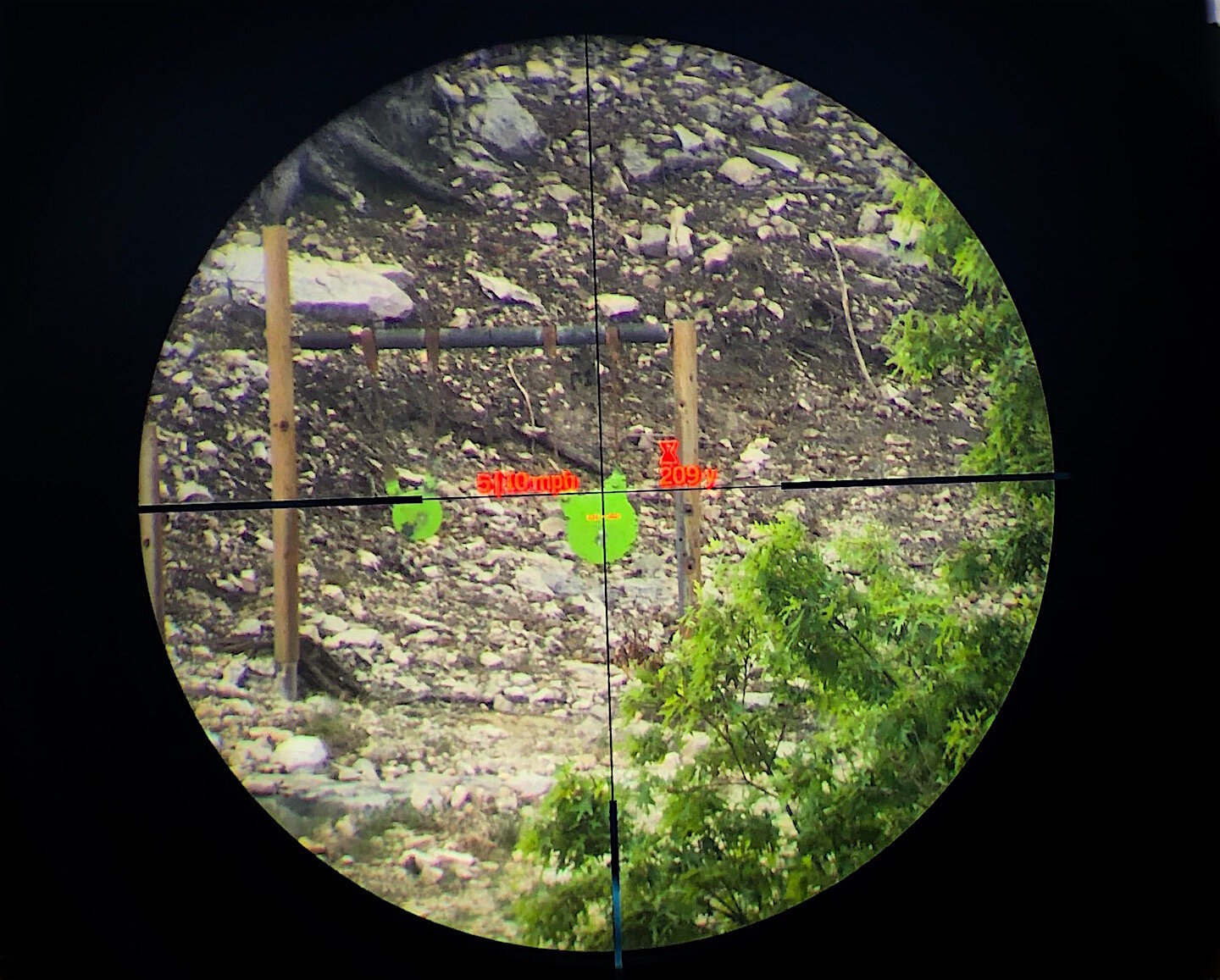Swarovski dS Rangefinder Scope
The Swarovski dS 5-25x52mm riflescope might be technology gone too far or the most effective tool ever invented for reducing wounding loss.
It all depends on how you use it.
Photo shows a big Swarovski dS scope atop a Bergara rifle.
Taking the Swarovski dS Test Drive
Five friends and I wrung out six of the new Swarovski dS wonder scopes at FTW shooting and hunter training ranch in Texas. The big scopes were mounted atop Bergara Premier HMR Pro rifles in 6.5 Creedmoor (apologies to Creedmoor haters.) At one station trainer Tim Fallon challenged us to hit twenty 9- and 12-inch steel plates at distances from 260 to 589 yards — in 10- to 20-mph crosswinds. Sometimes he told us to shoot one target at one distance, then find and shoot another at twice that distance, both in 10 seconds. As if that weren’t tough enough, some of the angles were steeply downhill. Anyone who’s ever shot small targets beyond 300 yards in conditions like that will appreciate the inherent challenges, but the Swarovski dS met them head on.
One of us, Tyler, a Marine sniper currently out of service, scored a perfect 20 on this course. A certain outdoor writer scored 19. Similar things happened at other stations, including one where instructor Doug Prichard had us smack five 9-inch plates from 350 to 450 yards before swinging wide left to take on a 6-inch popper at 600 yards. Four of us nailed five of the six. In a rare show of luck, the outdoor writer got all six.
Image shows tired shooter napping beside his rifle and Swarovski dS scope on the range.
Atop another barren ridge we were directed to shoot a 12-inch plate followed by a 9-inch plate in five seconds at ranges from 250 to 550 yards. Winds were gusting 20- to 30-mph from 10 o-clock across the canyon with a slight uplift component. Rei Hoang, the only woman in our party, slapped them all. So did Colton Bagnoli, a Montana police officer. Without that scope, I doubt they could have, so let’s take a hard look at this remarkable optical device.
Swarovski dS Includes Rangefinder
The heart of the dS is its built-in laser rangefinder. Anyone who has ever switched between a handheld laser and rifle in a hurry will appreciate the speed and convenience of getting a laser distance readout right in the scope’s eyepiece. Fast. But that’s not all. This dS also measures the angle of the shot and spits out the shoot-to range plus the remaining energy of your bullet at that distance! If you subscribe to the theory of minimal energy for clean kills, this scope will tell you when you’ve reached your limit. But it won’t do this with just a familiar numbered display like 367 yards and 1,750 f-p. It also illuminates the proper holdover line down the vertical reticle. Yes, no more counting stadia lines or dialing turrets. The dS puts the proper aiming point right in the eyepiece view. And that’s still not all…
Image shows view through a Swarovsk dS scope.
The dS reads temperature and atmospheric pressure and factors the effects of both (air density) on trajectory before lighting up that precise aiming point. Then, instead of just illuminating a red dot, the Swarovski dS lights up a horizontal red bar with windage hash marks at the proper locations to compensate for 5 mph and 10 mph crosswinds or 10 mph and 20 mph winds. That feature was a big part of the reason we all shot so well at varying distances in those big Texas winds. I can tell you it’s pretty reassuring to see a red windage aiming point for 20 mph at 473 yards at an 18-degree downhill angle. Of course, the shooter still has to measure or estimate the wind speed accurately. The Swarovski dS can’t do that yet. You also have to choose between the 5 and 10 mph marks or the 10 and 20 mph marks ahead of time. This is done via Bluetooth with your smartphone, which is also how you preload your bullet’s trajectory data.
Oh No! Smartphones, Apps, and Bluetooth With the Swarovski dS?
Oh boy, here we go. Another smartphone app interfering with one’s adventure. Another layer of technology between you and your prey, between you and your personal connection with Nature. Another battery powered hunting tool that can fail. Another crutch for untrained, ineffective “hunters” too lazy to do it the right way, the old fashioned way.
Well… Before we climb on that high horse, let’s look in the mirror. What is a modern, bolt-action rifle but a high tech step up from a muzzleloader? And what’s a muzzleloader but a technological advancement over a bow and arrow which is itself a high tech throwing spear? One can slice this salami pretty thin. And it’s up to each of us to do that for ourselves. Only we can decide how much gear advantage we want. Do you feel as if you’re cheating if you hunt with a smokeless powder cartridge? A 4X scope instead of open sights? A laser rangefinder instead of a line-of-sight estimate?
On the flip side, isn’t it better to minimize the chance of a poor hit by using a laser to precisely measure distance to target so you know exactly where to aim? Or not shoot at all because it’s too far? Isn’t it better to employ a powerful scope to clearly see your aiming point? Is a high tech scope that makes shots more precise really a bad thing?
Targets and Culling With Swarovski dS
Regardless your views on game hunting with a scope like this, you might appreciate the advantages of using one for target shooting, coyote hunting, or culling operations. Feral hogs and similar invasive species should be suitable subjects for a Swarovski dS. Instead of guessing and missing at long range, you can drop bullets right in the boiler room, often from so far away that your quarry doesn’t even realize what’s happening. A Swarovski dS could help you do your part to reduce the destructive impact of invasive species.
Image shows a feral hog, the perfect quarry for a Swarovski dS scope
First and Second Focal Plane Reticles
Appropriately for a laser rangefinder scope with these capabilities, the Swarovski dS power range runs from 5X up to 25X, which could cause some problems like parallax and too much power for convenient use of a first or second-focal plane reticle. A traditional side-focus dial addresses the parallax issue. Swarovski solved the “too much power” issue by including both first and second focal plane reticles.The fixed, duplex-style, black reticle is located in the second focal plane so it does not enlarge to overpower small targets at high magnifications. It works without batteries like any traditional reticle. The digital red aiming point reticles arise from the first focal plane so the target and sub-reticle spacing relationships aren’t changed. It isn’t necessary to use the scope at its highest power in order for the sub-reticle to be accurate.
This is incredibly convenient, freeing the shooter to dial any power he or she feels appropriate for any shooting situation. I often dialed power down so I could more easily keep the target in view and see my hits/misses at closer ranges. I turned it up when eyeing 6-inch plates at 600 yards. Each time the red horizontal aiming reticle appeared in the proper position along the vertical reticle line. So long as I didn’t wiggle or jerk the trigger, the 140-grain Hornady Match bullet went where the Swarovski was pointing.
Radical Mechanics of the Swarovski dS
Mechanically this scope is radically different from most. For one thing, you zero it by moving lens elements within the objective bell, not the erector tube. The top “turret” is really just a storage box for the 123CR battery, a tiny screw driver for opening the hatches to access the zero adjustment dials on the objective bell, and a “wrench” for more easily grasping the adjustment knobs. These little tools are easy to lose, not so easy to use. But they don’t need to be used often. Zero the scope/rifle and thereafter all reticle adjustments are handled by the on-board computer and heads-up display.
Photo shows elevation dial atop objvective bell of Swarovski dS scope.
Of course, there is a laser rangefinder within the main tube, which is undoubtedly why that tube is 40mm in diameter. We had to chuckle over Swarovski’s description of this as “slim design.” This led to some light-hearted marketing phrases like “a light 38.4 ounces,” and “the brightest 40mm main tube 52mm objective 5-25X laser-rangefinder scope in the world.”
The dS brochure says nothing about lens coatings, but I assume the Swarovski has used its usual best. Image quality was certainly top notch, but we weren’t shooting a half hour after sundown, either. Obviously light transmission can’t match that of a traditional scope because of the extra lens elements and laser rangefinder, but if light transmission was a problem, it certainly didn’t reveal itself to me. Target acquisition was quick and precise.
To my surprise this scope is rated waterproof to 13 feet submersion level. Given the $4,999.9999999… cost of this unit, I didn’t test this guarantee by dunking one in an FTW waterhole, but the guarantee will be reassuring during any rainy day shoot.
The dS's onboard rangefinder reaches to 1,500 yards, but the maximum illuminated reticle movement is only good for 1,120 yards. No problem. That’s about twice as far as this hunter ever plans to engage game.
Conclusion and Author’s Opinion of Swarovski dS Scope
My conclusion is that this is the fastest-to-employ, most precise scope I’ve ever used for hitting targets at unknown ranges out to 700 yards. I didn’t try any targets beyond that. I even waded through the smartphone app and set-up easily, which is a rare feat for me. I’m in no hurry to carry a 38-ounce scope on any mountain hunt, but it certainly wouldn’t overwhelm me on a flatland hog or coyote hunt.
PHoto shows a Bergara HMR Pro rifle with Swarovski dS scope.
As for the moral question, I’m torn. Heretofore I’ve been against high tech tools that make shooting too easy. But I appreciate the arguments in favor of reducing wounding loss due to poor range estimation and improper sight alignment. I worry that a lighted reticle will encourage poorly trained shooters to engage targets at ill-advised distances. Seriously, just because your scope and rifle are capable of putting a bullet on a 6-inch target at 800 yards doesn’t mean you are. Nor is a stationary target the same as an animated target that can jump, duck, or merely step forward. A lot can go wrong in the lag time between your brain saying “shoot” and your finger pressing the trigger, the firing pin falling to the primer, the powder burning to build up 60,000 psi of pressure, the bullet ripping down the bore, and — last but no least — said bullet flying across hundreds of yards of air and cross currents before reaching the target which might no longer be there.
If you're intrigued by a high tech sight like this, you should investigate the Swarovski dS further, especially if you can shoot with one. I'm predicting you'll be impressed by its speed and precision.Ron Spomer believes long range shooting is a fascinating challenge requiring study and a thorough understanding of rifles, scopes, cartridges, bullets, ballistics, and trajectory. It is not the same thing as hunting. Not by a long shot.





















